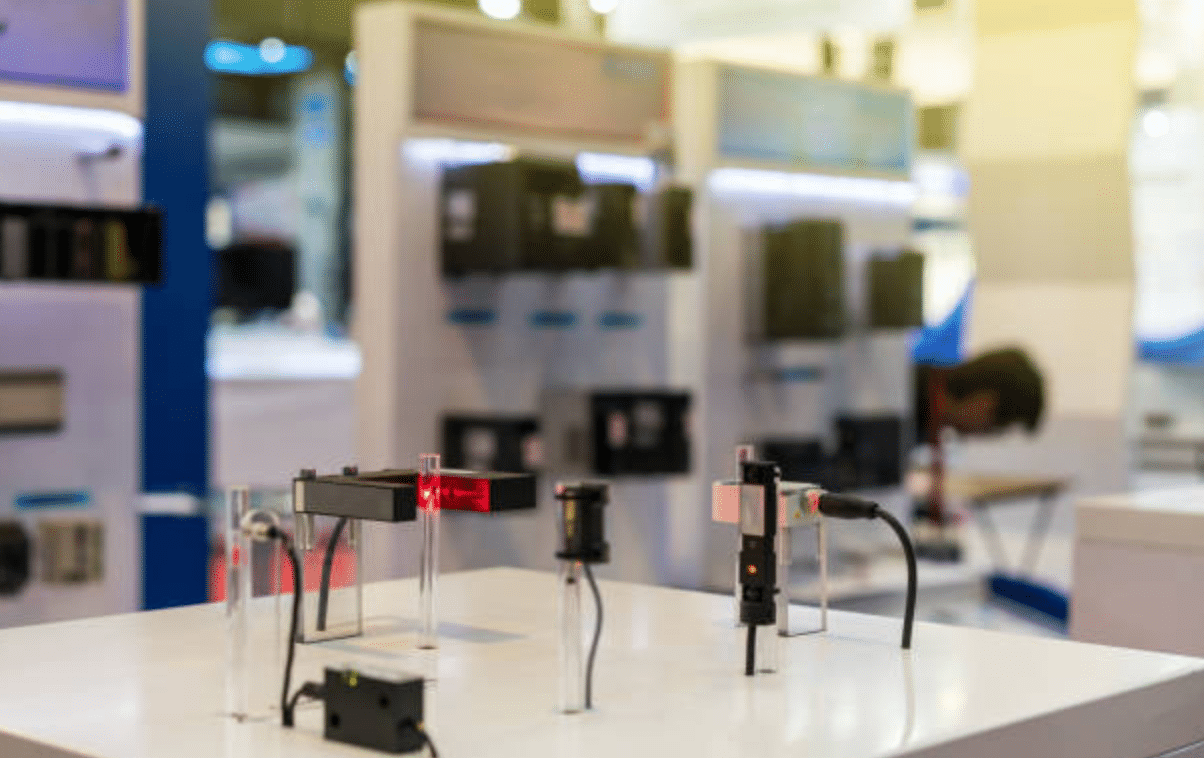When factories and machines operate smoothly, it’s often thanks to sensors that quietly keep everything in line. One of the most reliable of these is the humble Hall sensor. Because it can pick up a magnetic field without actually touching the moving parts, it has carved out a special place in motor controllers, robotic arms, production lines, and nearly any setup that needs to know exactly where something is or how fast it’s moving. This post takes a closer look at how Hall sensors work, where you’ll usually find them, what makes them stand out, and what you should think about when picking one for a job.
What Is a Hall Sensor?
A Hall sensor, officially called a Hall effect sensor, changes its voltage output whenever the magnetic field around it shifts. The device carries the name of Edwin Hall, the American physicist who first spotted the effect back in 1879. Here’s the basic idea: run a current through a thin strip of metal or semiconductor, then let a magnet slide nearby. Almost magically, a tiny voltage pops up sideways to the current flow. That voltage is what the sensor makes sense of and sends out as a usable electrical signal.
There are two main types of Hall sensors:
- Analog Hall sensors produce a voltage that steadily rises or falls as the magnetic field gets stronger or weaker. Because of this smooth output, you’ll often find them in position and proximity detection tasks.
- Digital Hall sensors behave more like a light switch—they flip on or off once the magnetic field crosses a certain level. This on-or-off signal makes them perfect for spotting the arrival of a magnet or measuring how fast something is spinning.
Both types are solid-state devices, which means no gears, springs, or rattling parts. That absence of moving elements gives them impressive reliability, allowing them to keep performing well even in dust, moisture, or extreme temperatures. For factories and workshops that want to slot magnetic sensing into their automated lines, OMCH has a tailored range of proximity and magnetic switch sensors that can fit many different jobs.
Where Industry Puts Hall Sensors to Work
Because Hall effect sensors can detect magnets without needing to touch them, they are handy across a wide span of industrial tasks. Their contact-less design cuts down on wear, so you’ll see them in places where pushing, pulling, or rubbing could quickly ruin a device.
Keeping Motors in Check
One of the earliest and still most frequent roles for Hall sensors is in electric motors, where they keep tabs on how fast the shaft spins or where the rotor sits. In brushless DC motors, for example, arrays of Hall sensors coordinate the power switches, ensuring the motor starts smoothly and runs with steady strength.
Hall effect sensors are one of those quiet heroes you find tucked away in all sorts of modern gear, from factory robots and conveyor belts to CNC machines and the latest electric cars. Because they can spot a magnetic field from a distance with no physical contact, they make perfect end-position detectors. For instance, you can screw a tiny Hall sensor to the body of a pneumatic cylinder while sticking a small magnet to the moving piston. When the piston slides home, the sensor switches on and tells the controller that the job is done.
You’ll also find Hall sensors working hard in turbine flow meters used for liquids. As liquid races through, it spins magnetic blades attached to the rotor. Every time a blade passes the sensor, it sends a pulse that the control system translates into flow rate. These readings are vital in places like chemical dosing stations, municipal water plants, and oil rigs, where knowing the exact flow can keep processes running smoothly and safely.
In the world of robotics and industrial automation, space is often limited and conditions can get messy. Hall sensors are small enough to fit almost anywhere, yet tough enough to shrug off dust, spilled oil, and the constant vibration of heavy machinery. On an automated assembly line, for example, they confirm whether two parts have latched together or track the travel of a linear actuator with pinpoint accuracy.
Elevators and industrial sliding doors depend on them for safety as well. By constantly monitoring the position of a cab or door panel, a Hall sensor can trigger an emergency stop if something isn’t right, helping to protect both equipment and people. It’s a simple, reliable solution that reminds us how a little magnetism can go a long way.
Why Hall Sensors Are Winning Over Industry Pros
More factories and warehouses are turning to Hall effect sensors, and it’s easy to see why they keep popping up on parts lists. Here’s what makes them a go-to choice in automation:
- No Touch, No Trouble: Because these sensors work without any moving parts actually meeting, they don’t grind down over time. Less friction means they shrug off dirt and oil, giving them a longer life.
- Distance Meets Strength: A good Hall sensor can sense a magnetic field from just a few millimeters to several centimeters away, depending on how strong the magnet is. That flexibility covers most shop-floor needs.
- Built for the Grind: Vibrating conveyors, dusty machine cells, or outdoor cabinets exposed to rain—these sensors keep working. They’re engineered to handle wide temperature swings and still provide reliable readings.
- One Sensor, Many Jobs: Positioning a gate, counting wheel turns, telling direction, or checking if a door is closed, a single Hall sensor can usually tackle those tasks. This cross-industry versatility cuts down on the number of different parts a plant has to stock.
- Easy to Hide: With sizes that can fit inside a thumbprint, Hall sensors slide neatly into tight enclosures or cramped robotic arms without crowding other components.
- Sips Power: Many models run on just a few microamps, so they’re perfect for battery-run devices or when a green approach is high on the project list.
Adding Hall sensors into an automated line usually means clearer feedback loops, fewer sudden breakdowns through predictive alerts, and a smoother overall workflow.
What to Nail Down Before You Buy
Picking the right Hall sensor isn’t just a matter of whether you want digital output or analog voltage. Engineers and buyers have a checklist of details that can make or break the installation, so a bit of homework upfront saves headaches later.
Matching Sensor Sensitivity to Magnetic Strength
When choosing a magnetic sensor, first think about how strong the magnetic field will really be. If the magnet is weak or placed far away from the sensor, you’ll need a part that is more sensitive to pick up the signal clearly. A lower-sensitivity model works fine when the field is strong, but it might miss the mark with a distant or feeble source.
Where and How the Sensor Will Be Mounted
Next, consider the mounting situation. Will the sensor sit flush with a panel, get buried inside a case, or move with rotating and sliding parts? The reading is only as good as the sensor’s alignment with the magnet, so plan for an installation that keeps the two directly facing each other.
Choosing Between Analog and Digital Signals
Think about the output signal your control system wants to see. Does it prefer a steady analog voltage, or is a snap-on digital switch better for the job? For counting wheel rotations or detecting fast speed changes, a high-speed digital sensor is almost always the right call.
Weather and Workplace Protection Ratings
Sensors that live outdoors or inside heavy industry need extra protection. Check their ratings for water, oil, chemicals, and extreme heat before making the buy. Models stamped with IP67 or IP68 usually handle these rough environments, thanks to tough seals and sturdy housings.
Power Supply and Output Configuration
Finally, verify that the sensor’s power range matches your system—common values are 5V, 12V, or 24V. Also look for the right type of output, whether it’s open-collector, push-pull, or something else, so it fits your circuitry without extra headaches.
When you team up with a parts supplier that shares complete datasheets and real-world application support, the job of hooking up sensors becomes a lot easier—and a lot more reliable. Companies like OMCH, which have deep know-how in both proximity and magnetic sensing, can really help things go smoothly the first time and keep them working into the future.
How OMCH Lends a Hand to B2B Customers Using Hall Sensors
Known for its solid footing in automation and sensing, OMCH has a broad lineup of magnetic solutions, especially Hall sensors made for tough industrial jobs. Their products are built to hold up in settings such as heavy-duty manufacturing, precise motion control, and complex fluid-handling systems.
What OMCH offers includes:
- Tough sensor casings that withstand dust, heat, and vibration
- Different form factors that fit nearly anywhere—from embedded boards to panel mounts
- Easy plug-and-play with main control platforms using either analog or digital signals
- Helpful integration tools like ready-to-download CAD files, detailed datasheets, and one-on-one expert advice
For engineers working on motor drives, assembly robots, or next-gen smart factories, OMCH Hall sensors strike a solid balance between ruggedness, responsiveness, and setup flexibility.
You can browse the complete range of magnetic proximity switches, including Hall-based models ready for factory use, in the https://www.omchsmps.com/es/path/proximity-switch/ .
Conclusion
Hall sensors are a game-changing piece of tech found in almost every corner of industrial automation today. Because they detect magnetic fields silently and without any moving parts, they can be used for everything from figuring out whether a machine part is in the right place to measuring how fast a motor is spinning. That dependability and accuracy makes them a go-to choice for B2B companies that simply cannot afford to take chances with performance.
Whether they are wired into a large motor-control setup or a safety system designed to shut down power in an emergency, Hall sensors help keep operations running smoothly and equipment lasting longer. By partnering with reliable suppliers like OMCH, businesses don’t just get a product; they also tap into top-notch technical support and a global supply chain that makes sure replacements and new orders are always on time.





